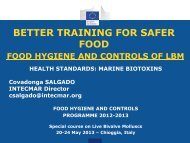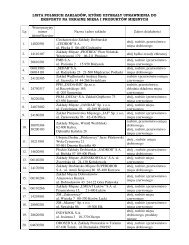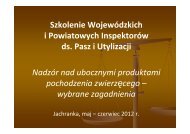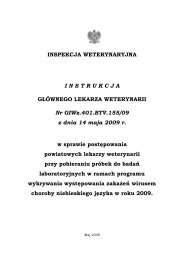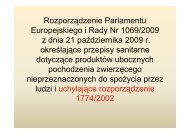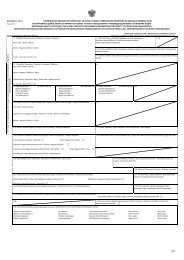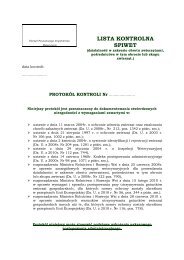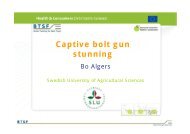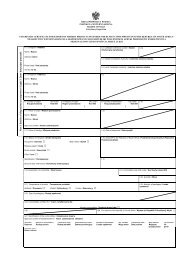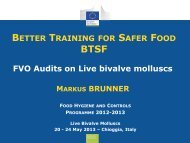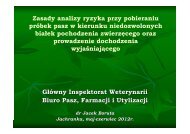General Guidance for transit and transhipment - European ...
General Guidance for transit and transhipment - European ...
General Guidance for transit and transhipment - European ...
You also want an ePaper? Increase the reach of your titles
YUMPU automatically turns print PDFs into web optimized ePapers that Google loves.
EUROPEAN COMMISSIONHEALTH AND CONSUMERS DIRECTORATE-GENERALAnimal health <strong>and</strong> welfareInternational questions (multilateral)SANCO/10844/201108.04.2011ENWORKING DOCUMENTGENERAL GUIDANCE FOR CONSIGNMENTS OFLIVE ANIMALS AND ANIMAL PRODUCTS FROM THIRD COUNTRIESIN TRANSIT OR TRANSHIPMENTThis document has been established <strong>for</strong> in<strong>for</strong>mation purposes only. It has not been adoptedor in any way approved by the <strong>European</strong> Commission.The <strong>European</strong> Commission does not guarantee the accuracy of the in<strong>for</strong>mation provided,nor does it accept responsibility <strong>for</strong> any use made thereof. Users should there<strong>for</strong>e take allnecessary precautions be<strong>for</strong>e using this in<strong>for</strong>mation, which they use entirely at their ownrisk.
PURPOSE OF THIS DOCUMENTThis document is mainly directed at competent authorities <strong>and</strong> morespecifically at border inspection posts, <strong>and</strong> aims to give guidance on theimplementation of the requirements governing the import <strong>and</strong> <strong>transit</strong> controlsystem <strong>for</strong> live animals <strong>and</strong> animal products originating from thirdcountries.NOTEThis document is an evolving document <strong>and</strong> may be updated as necessary totake account of experiences <strong>and</strong> in<strong>for</strong>mation from competent authorities <strong>and</strong>private operators in third countries, from importers <strong>and</strong> from theCommission's inspection service, the Food <strong>and</strong> Veterinary Office (FVO).i
ABBREVIATIONS AND DEFINITIONS USED IN THE GUIDANCE DOCUMENTBIPCVEDDG SANCOEEAEUHCLVUNHCRASFF messageSLVUTRACESBorder Inspection Post as defined in Council Directives 91/496/EEC<strong>and</strong> 97/78/ECCommon Veterinary Entry Document <strong>for</strong> animal products as laiddown in Annex III to Commission Regulation (EC) No 136/2004 <strong>and</strong><strong>for</strong> live animals as laid down in Annex I to Commission Regulation(EC) No 282/2004Directorate <strong>General</strong> Health <strong>and</strong> Consumer<strong>European</strong> Economic Area<strong>European</strong> UnionHuman consumptionLocal Veterinary UnitNot <strong>for</strong> human consumptionMessages used in the Rapid Alert System <strong>for</strong> Food <strong>and</strong> Feed of the<strong>European</strong> CommissionSuper Local Veterinary UnitTRAde Control <strong>and</strong> Expert System introduced by CommissionDecision 2004/292/ECii
TABLE OF CONTENTS1. PURPOSE ...................................................................................................................12. DEFINITIONS ............................................................................................................13. BACKGROUND.........................................................................................................24. ADVANCE NOTIFICATION, CERTIFICATION & NON-CONFORMINGCONSIGNMENTS......................................................................................................34.1. Advance notification of consignments ..............................................................34.1.1. Animal Products ..................................................................................34.1.2. Live Animals .......................................................................................44.1.3. <strong>General</strong> ................................................................................................44.2. Certification of consignments............................................................................54.2.1. <strong>General</strong> ................................................................................................54.2.2. Replacement Certificates.....................................................................54.3. Splitting of non-con<strong>for</strong>ming consignments in <strong>transit</strong>........................................65. REQUIREMENTS FOR FREE ZONES, FREE/CUSTOMSWAREHOUSES/SHIP SUPPLIERS/SHIIPS.............................................................75.1. <strong>General</strong> requirements.........................................................................................75.2. Requirements <strong>for</strong> separation <strong>and</strong> storage of non-con<strong>for</strong>mingconsignments .....................................................................................................75.3. Requirements <strong>for</strong> communication .....................................................................85.3.1. Movement from the entry BIP to free zones, free/customswarehouses or ship suppliers/ships......................................................85.3.2. Movement from the free zones or free/customs warehouses tothe exit BIP..........................................................................................95.3.3. Movement from the free zones or free/customs warehouses toa ship supplier......................................................................................95.3.4. Movement from the free zones, free/customs warehouses orship suppliers to a ship or to a specially approved warehouse(Article 13(2) of Directive 97/78/EC) ...............................................105.4. Requirements <strong>for</strong> registration..........................................................................106. PROCEDURES AT EXIT BIPS ...............................................................................116.1. <strong>General</strong> ...........................................................................................................116.2. Irregularities ....................................................................................................127. TRADE WITH THIRD COUNTRIES......................................................................127.1. Russian Memor<strong>and</strong>um.....................................................................................12iii
7.2. Rejections by the third country authorities......................................................137.3. Derogations <strong>for</strong> consignments from Russia to <strong>and</strong> from Kaliningrad.............138. CONSIGNMENTS TO NATO BASES/US BASES ................................................139. ANIMAL PRODUCTS TRANSHIPPED AT PORTS OR AIRPORTS...................149.1. <strong>General</strong> ...........................................................................................................149.2. Advance notifications <strong>for</strong> transhipped consignments .....................................159.3. Destination of transhipped consignments........................................................169.3.1. Consignments destined <strong>for</strong> the import in the Union/EEA inthe second BIP (Article 9 of Directive 97/78/EC) ............................169.3.2. Consignments destined <strong>for</strong> third countries (Article 11 (2)(b)of Directive 97/78/EC) ......................................................................169.4. Veterinary checks to be carried out on transhipped consignments .................179.4.1. Be<strong>for</strong>e the minimum time period <strong>for</strong> veterinary checks laiddown in Article 2 <strong>and</strong> 3 of Decision 2011/215/EU has elapsed(12 hours at airports <strong>and</strong> 7 days at ports) ..........................................179.4.2. After the minimum time period <strong>for</strong> veterinary checks laiddown in Article 2 <strong>and</strong> 3 of Decision 2011/215/EU has elapsed(12 hours at airports <strong>and</strong> 7 days at ports) ..........................................189.4.3. Extension of the minimum period in ports from 7 to 14 days<strong>for</strong> consignments being transhipped directly to a third country(Article 3 (2) of 2011/215/EU)..........................................................199.4.4. After the maximum time period <strong>for</strong> veterinary checks laiddown in Article 2 (2) of Decision 2011/215/EU has elapsed(48 hours at airports <strong>and</strong> 20 days at ports) ........................................1910. CONSIGNMENTS OF LIVE ANIMALS FOR TRANSIT OR BEINGTRANSHIPPED........................................................................................................1910.1. Consignments of live animals in <strong>transit</strong> ..........................................................1910.2. Transhipped consignments of live animals .....................................................2010.2.1. Consignments of live animals not unloaded in the BIP ofarrival ...........................................................................................2010.2.2. Consignments of live animals unloaded in the BIP of arrival<strong>and</strong> continuing their journey with a different vessel or aircraft ........21ANNEX ............................................................................................................................22iv
1. PURPOSEThe purpose of this guidance is to achieve a more harmonised approach in Member Stateswith respect to the implementation of:1. Council Directive 91/496/EEC of 15 July 1991 laying down the principles governingthe organisation of veterinary checks on animals entering the Community from thirdcountries <strong>and</strong> amending Directives 89/662/EEC, 90/425/EEC <strong>and</strong> 90/675/EEC 1 ,2. Council Directive 97/78/EC of 18 December 1997 laying down the principlesgoverning the organisation of veterinary checks on products entering the Community fromthird countries 23. Council Directive 2002/99/EC of 16 December 2002 laying down the animal healthrules governing the production, processing, distribution <strong>and</strong> introduction of products ofanimal origin <strong>for</strong> human consumption 3 , <strong>and</strong>,4. Regulation (EC) No 1069/2009 of the <strong>European</strong> Parliament <strong>and</strong> of the Council of21 October 2009 laying down health rules as regards animal by-products <strong>and</strong> derivedproducts not intended <strong>for</strong> human consumption <strong>and</strong> repealing Regulation (EC) No1774/2002 (Animal by-products Regulation) 4 .These concern consignments of animal products <strong>and</strong> live animals from third countries:– in <strong>transit</strong> to another third country– in storage in free/customs warehouses or ship suppliers <strong>and</strong> destined <strong>for</strong> eventual<strong>transit</strong> to another third country or ship supply– transhipped in a first Union/EEA port/airport border inspection post (BIP) of arrival <strong>for</strong>later importation into the Union/EEA through a second port/airport BIP– transhipped in the first Union/EEA port/airport BIP of arrival <strong>for</strong> <strong>transit</strong> to a thirdcountry.2. DEFINITIONSImport:The release of animal products <strong>for</strong> free circulation, or, the intention torelease feed or food <strong>for</strong> free circulation within the meaning of Article 79 ofRegulation (EEC) No 2913/92 5 into Union/EEA territory - as referred to inAnnex I to Regulation (EC) No 882/2004 6 ; reference is also made toArticle 2(h) of Directive 97/78/EC, Article 2(15) of Regulation (EC) No123456OJ L 268, 24.09.1991, p. 56OJ L 24, 30.01.1998, p. 9OJ L 18, 23.01.2003, p. 11OJ L 300, 14.11.2009, p. 1Council Regulation (EEC) No 2913/92 of 12 October 1992 establishing the Community Customs Code,OJ L 302, 19.10.1992, p. 1Regulation (EC) No 882/2004 of the <strong>European</strong> Parliament <strong>and</strong> of the Council of 29 April 2004 onofficial controls per<strong>for</strong>med to ensure the verification of compliance with feed <strong>and</strong> food law, animalhealth <strong>and</strong> animal welfare rules, OJ L 165, 30.04.2004 <strong>and</strong> re-published in OJ L 191, 28.05.2004, p.11
882/2004, to the EEA-Agreement 7 <strong>and</strong> to the Agreement between the<strong>European</strong> Community <strong>and</strong> the Swiss Confederation on trade in agriculturalproducts 8 .Non-con<strong>for</strong>ming consignments: animal products that do not meet public health EUrequirements. As they do not meet these requirements, they may not beimported into the Union/EEA or intended <strong>for</strong> the Union/EEA market. Noncon<strong>for</strong>mingconsignments are destined or intended <strong>for</strong> free zones,free/customs warehouses, ship suppliers or ships leaving the coastal watersof the Union/EEA territory; they may be in <strong>transit</strong> from one third countryto another through the Union/EEA territory by road, rail or waterways orthey may be transhipped from an EU port/airport to a third country.Transit:the movement of non-con<strong>for</strong>ming consignments or, the movement of liveanimals con<strong>for</strong>ming to EU requirements across Union/EEA territory byroad, rail, or waterway transport from one third country to another. The<strong>transit</strong> may be direct or indirect (involving a period of storage) as follows:Direct <strong>transit</strong>: movement of above consignments across Union/EEA territory fromthe BIP of entry directly to the BIP of exit, or to a ship leaving the coastal waters ofthe Union/EEA territory.Indirect <strong>transit</strong>: movement of above consignments from the BIP of entry to a freezone, free/customs warehouse/ship supplier <strong>for</strong> storage first <strong>and</strong> then onto the BIP ofexit, or a ship supplier, or a ship, leaving the coastal waters of the Union/EEAterritory.Transhipment: the movement of a consignment from a third country from avessel/aircraft in an Union/EEA port/airport served by an Union/EEA approved BIP toanother vessel/aircraft in the same port/airport within the area of the same customs officeresponsible <strong>for</strong> import <strong>and</strong> export or within the same free zone <strong>for</strong> onward travel. Due tothe numerous, different cases in which derogations <strong>for</strong> <strong>transhipment</strong>s are applicable, inparticular <strong>for</strong> live animals, these are further defined in Chapters 9 <strong>and</strong> 10.3. BACKGROUNDDirectives 91/496/EEC related to live animals <strong>and</strong> 97/78/EC related to animal products setout the veterinary procedures <strong>and</strong> requirements <strong>for</strong> commercial consignments of liveanimals <strong>and</strong> animal products. These procedures <strong>and</strong> requirements must be followed inorder to import into or <strong>transit</strong> through the EU.While consignments to be imported into the EU must meet both animal <strong>and</strong> public healthrequirements, there are no public health requirements <strong>for</strong> consignments of animal productsin <strong>transit</strong>. Consignments of animal products in <strong>transit</strong> are required to only meet animalhealth requirements.Directive 2002/99/EC, Commission Decisions 2005/92/EC 9 <strong>and</strong> Regulation (EC) No1069/2009 specify these animal health requirements that need to be fulfilled <strong>for</strong>78OJ No L 1, 3.1.1994, p. 3OJ L 114, 30.04.2002, p. 1322
consignments of animal products intended <strong>for</strong> human consumption (HC) <strong>and</strong> those that arenot <strong>for</strong> human consumption (NHC). In both cases, they state that all consignments ofanimal products must fulfil animal health requirements, whether they are <strong>for</strong> import or<strong>transit</strong>.In addition consignments destined to third countries have to come from a third countrywhose products are not specifically prohibited entry on to the territories listed in Annex Ito Directive 97/78/EC. Currently no Commission Decision is in <strong>for</strong>ce concerning aMember State who decided to waive from this requirement <strong>for</strong> consignments transhippedfrom one aircraft/vessel to the other aircraft/vessel <strong>for</strong> the purpose of re-dispatch to a thirdcountry without further stop on the territories of the Union/EEA (provided <strong>for</strong> in Article11 (1)(a) of Directive 97/78/EC – see also chapter 9.3.2.).Live animals physically entering the territory of the EU must always fulfil EU animal <strong>and</strong>public health import requirements, whether <strong>for</strong> import or <strong>transit</strong>. In the absence of EUimport requirements <strong>for</strong> certain species of live animals, these must comply with nationalrules as provided <strong>for</strong> in Council Directive 92/65/EC 10 .All consignments of live animals <strong>and</strong> animal products introduced into the territory of theEU must be presented at an EU approved BIP to undergo veterinary checks unless thereare specific exemptions, e.g. <strong>for</strong> personal imports, pet animals.Whilst the guidance document mainly addresses consignments in <strong>transit</strong> <strong>and</strong> <strong>for</strong><strong>transhipment</strong>, several chapters (e.g 4.1 <strong>and</strong> 4.2) are also applicable <strong>for</strong> consignmentsdestined <strong>for</strong> importation into the EU.4. ADVANCE NOTIFICATION, CERTIFICATION & NON-CONFORMING CONSIGNMENTS4.1. Advance notification of consignments4.1.1. Animal ProductsAccording to Article 3(3) of Directive 97/78/EC, Member States shall ensure that personsresponsible <strong>for</strong> the load <strong>for</strong>ward the in<strong>for</strong>mation requested in the first part of the CommonVeterinary Entry Document (CVED) in advance to the BIP to which the consignments ofanimal products are to be submitted <strong>for</strong> veterinary checks.Article 2 (1) of Regulation (EC) No 136/2004 11 clarifies that the CVED shall be used tonotify the arrival of the consignments of animal products to the BIP be<strong>for</strong>e their physicalarrival on Community territory.91011Commission Decision 2005/92/EC of 2 February 2005 as regards animal health conditions, certification<strong>and</strong> <strong>transit</strong>ional provisions concerning the introduction <strong>and</strong> storage period <strong>for</strong> consignments of certainproducts of animal origin in free zones, free warehouses <strong>and</strong> premises of operators supplying crossborder means of sea transport in the Community, OJ L 31, 04.02.2005, p. 62Council Directive 92/65/EEC of 13 July 1992 laying down animal health requirements governing tradein <strong>and</strong> imports into the Community of animals, semen, ova <strong>and</strong> embryos not subject to animal healthrequirements laid down in specific Community rules referred to in Annex A (I) to Directive90/425/EEC, OJ L 268, 14.9.1992, p. 54Commission Regulation (EC) No 136/2004 of 22 January 2004 laying down procedures <strong>for</strong> veterinarychecks at Community border inspection posts on products imported from third countries, OJ L 21,28.01.2004, p. 113
The exact timeframe <strong>for</strong> advance notification is not specified in EU legislation. It isrecommended, however, that advance notification in ports should be provided at least onthe previous working day be<strong>for</strong>e the arrival of the consignments, except <strong>for</strong> ferries whereit is recommended that advance notification takes place just be<strong>for</strong>e arrival. Advancenotification in airports should be provided four hours be<strong>for</strong>e the arrival of the plane <strong>for</strong>long haul flights <strong>and</strong> from take-off at the previous airport <strong>for</strong> short haul flights (as inCommission Regulation (EEC) No 2454/1993 12 ). Advance notification <strong>for</strong> road <strong>and</strong> railBIPs is twelve (12) hours be<strong>for</strong>e arrival.Member States may decide, on the basis of local conditions, to require advancenotification <strong>for</strong> specific BIPs at least on the previous working day.Type of BIPPortAirportRoadTime of notification in advance• All vessels: previous working day• Ferries: just be<strong>for</strong>e their arrival• Long haul flights: four hours be<strong>for</strong>e arrival of the plane• Short haul flights: from take off at the previous airport12 hours be<strong>for</strong>e arrivalRail12 hours be<strong>for</strong>e arrivalTable 1: time periods <strong>for</strong> advance notification of product consignments to BIPs4.1.2. Live AnimalsAccording to Article 3 (1) of Directive 91/496/EEC, Member States shall ensure thatimporters give one working day's notice to the veterinary staff of the BIP where liveanimals are to be presented specifying the number, nature <strong>and</strong> estimated time of arrival ofthe animals.Article 1 (1) of Regulation (EC) No 282/2004 13 specifies further that the personresponsible <strong>for</strong> the load shall give notice of the entry of any animal into the Community atleast one working day be<strong>for</strong>e the expected arrival of the animal(s) on Communityterritory. Such notifications shall be made to the inspection staff of the BIP using the firstpart of the CVED.4.1.3. <strong>General</strong>In cases of non-compliance, e.g. delayed or lack of advance notification, it is up toMember States to decide the appropriate action to be taken as provided <strong>for</strong> in Article 54<strong>and</strong> 55 of Regulation (EC) No 882/2004. The action taken should have as its aim theremoval of repeated non-compliances <strong>and</strong> might vary from administrative measures tofines up to refusal of the consignment. These measures may be applied progressively1213Commission Regulation (EEC) No 2454/93 of 2 July 1993 laying down provisions <strong>for</strong> theimplementation of Council Regulation (EEC) No 2913/92 establishing the Community Customs Code,OJ L 253, 11.10.1993, p. 1Commission Regulation (EC) No 282/2004 of 18 February 2004 introducing a document <strong>for</strong> thedeclaration of, <strong>and</strong> veterinary checks on, animals from third countries entering the Community, OJ L49, 19.2.2004, p. 114
according to the severity of the shortcoming <strong>and</strong> the history of compliance of the personresponsible <strong>for</strong> the load.4.2. Certification of consignments4.2.1. <strong>General</strong>Article 7 (1) <strong>and</strong> 11 (2) (a) of Directives 97/78/EC <strong>and</strong> Article 7 of Directive 91/496/EECrequire the original veterinary certificates or original veterinary documents to be presentedin the BIP of arrival.If the third country of origin provides the veterinary certificate in TRACES, the personresponsible <strong>for</strong> the load may use this to clone the first part of the CVED. In that case apaper veterinary certificate stamped <strong>and</strong> signed by the official of the competent authorityof the third country has to be provided to the BIP of arrival.In cases where the destination address in the veterinary certificate is different from that inthe CVED, customs documents or other accompanying papers should be checked to verifythe destination address.The original veterinary documentation, including the specific animal health certificaterequested in EU legislation should travel onwards with the relevant consignment to thefree/customs warehouses/ship supplier or to the third country together with the relevantCVED (Article 3 (4) of Regulation (EC) No 136/2004 <strong>and</strong> Article 3 (7) of Regulation(EC) No 282/2004). The original specific animal health certificate on entry to the EUshould be the same as that used when exiting the EU <strong>and</strong> no change to it should be madeduring the <strong>transit</strong> of the consignment. The only exception to this being <strong>for</strong> live animalswhen animals are found to have died during the journey, when explanation has to be madeto the difference in the number of animals indicated on the health certificate <strong>and</strong> in theCVED.As inconsistencies may be identified during documentary <strong>and</strong> identity checks as provided<strong>for</strong> in Article 4 of Directive 97/78/EC <strong>and</strong> in Article 4 of Directive 91/496/EEC, inrelation to the in<strong>for</strong>mation contained in the veterinary certificates or documents, thefollowing Chapter refers to replacement certificates.4.2.2. Replacement CertificatesIn the absence of EU legislation on this matter, guidance can be obtained from the texts ofthe international st<strong>and</strong>ard-setting body Codex Alimentarius. In the Guidelines <strong>for</strong> Design,Production, Issuance <strong>and</strong> Use of Generic Official Certificates (CAC/GL 38-2001 14 ) issuedby the Codex Alimentarius Commission 15 , replacement certificates are <strong>for</strong>eseen <strong>for</strong> certainadministrative corrections or if the certificates were lost or damaged.Replacement certificates must be clearly marked to indicate that they are replacing theoriginal certificate. A replacement certificate should also reference the number of theoriginal certificate that it supersedes <strong>and</strong> the date the original was signed. The originalcertificate should be cancelled <strong>and</strong>, where possible, returned to the issuing authority.1415Formerly Guidelines <strong>for</strong> Generic Official Certificate Formats <strong>and</strong> the Production <strong>and</strong> Issuance ofCertificates. Adopted 2001. Revisions 2005, 2007.Further in<strong>for</strong>mation under: http://www.codexalimentarius.net/web/index_en.jsp#5
Replacement certification should not be regarded as a normal practice but only <strong>for</strong>administrative errors, which are obvious (e.g. mismatch in container number, spellingerrors in seal numbers, addresses, product description or other in<strong>for</strong>mation) <strong>and</strong> in caseswhere the change would not reflect differently to the consignment itself, such as thenumber of boxes, the weight of the consignment <strong>and</strong> particularly issues such as theestablishment of origin. In cases of consignments <strong>for</strong> which there are different container<strong>and</strong> seal numbers indicated in the original certificates than there are in reality, thecertification did not take place in accordance with the general certification rules laid downin Council Directives 96/93/EC 16 <strong>and</strong> 2002/99/EC.If replacement certification is sought, the requirements <strong>for</strong> signing certificates, inparticular that the signatory was in control <strong>and</strong> witnessed the consignment attested to onthe original certificate should always borne in mind – this refers to the principles <strong>for</strong>certification as laid down in particular in Article 3 of Directive 96/93/EC.The relevant consignment needs to be detained by the BIP until the replacement certificateis received <strong>and</strong> the veterinary checks can be carried out. The whole process should bedocumented at the BIP (e.g. original certificate, communication with the competentauthority of the third country of origin, final certificate).4.3. Splitting of non-con<strong>for</strong>ming consignments in <strong>transit</strong>According to Article 11 (2 c) 2 nd indent of Directive 97/78/EC, consignments <strong>for</strong> direct<strong>transit</strong> to third countries shall be transported, in vehicles or containers sealed by theauthorities, without being unloaded or split after leaving the BIP of arrival.In order to comply with this requirement, multiple container consignments under oneveterinary certificate must be of the same origin (third country <strong>and</strong> region). They must beconveyed by the same transport means to the BIP of entry <strong>and</strong> must travel to the samefinal destination as a single unit without being split.If, however, consignments need to be/are split in the BIP of arrival, copies of theveterinary certificate must be provided <strong>for</strong> each part consignment reflecting the new,smaller amount. Each copy must be authenticated by the competent veterinary authority<strong>and</strong> <strong>for</strong> ease of reference, the number of the corresponding daughter CVED should beadded. The daughter CVEDs issued should follow each part consignment together withthe authenticated copied veterinary certificate to the exit BIP. The original veterinarycertificate with the original, or now remaining, amount should follow the last partconsignment. Appropriate records have to be kept to ensure that no amount higher thanwhat was originally on the mother CVED leaves the BIP of arrival.Similar provisions apply if the consignment is in indirect <strong>transit</strong> ie. stored in afree/customs warehouse in the interim.16Council Directive 96/93/EC of 17 December 1996 on the certification of animals <strong>and</strong> animal products,OJ L 13, 16.1.1997, p. 286
1- Copy of veterinary certificate + daughter CVEDConsignment: Original veterinary certificate2- Copy of veterinary certificate + daughter CVEDBIPentryofCVED with thetotal amountBIP of exit3-Original veterinary certificate + daughter CVEDSchema 1: overview on splitting non-con<strong>for</strong>ming consignments in <strong>transit</strong>In cases where part of a multiple container consignment is rejected in the BIP of arrival,the whole consignment has to be rejected as the original health certificate has to beinvalidated <strong>and</strong> returned to the third country of origin. If, however, in one container boxesare damaged during transport, the consignment could be split separating out the damagedpart. A mother CVED should be issued <strong>for</strong> the whole amount without completion of thesecond part of the CVED, while daughter CVEDs have to be issued <strong>for</strong> the part amounts.While <strong>for</strong> both part consignments, replacement certificates may be requested, or it shouldbe clarified with the third country of destination if the original certificate will be accepteddespite the fact that the number of boxes <strong>and</strong> the weight does not match any more with theconsignment.5. REQUIREMENTS FOR FREE ZONES, FREE/CUSTOMS WAREHOUSES/SHIPSUPPLIERS/SHIIPS5.1. <strong>General</strong> requirementsArticle 12 (4)(b) <strong>and</strong> Article 13 (1)(a) of Directive 97/78/EC requires free zones,free/customs warehouses to be approved <strong>and</strong> ship suppliers to be authorised <strong>for</strong> thestorage of non-con<strong>for</strong>ming consignments. Both Articles <strong>and</strong> Commission Decision2000/571/EC 17 detail the requirements to be fulfilled <strong>for</strong> the approval <strong>and</strong> theauthorisation of these premises. In addition Article 12 (10) requires Member States tosubmit to the Commission the list of approved free zones, free <strong>and</strong> customs warehouses<strong>and</strong> authorised ship suppliers, which are published under the following link:http://ec.europa.eu/food/animal/bips/warehouses_en.htm5.2. Requirements <strong>for</strong> separation <strong>and</strong> storage of non-con<strong>for</strong>ming consignmentsArticle 12 (4)(b) 4 th indent of Directive 97/78/EC requires free zones, free/customswarehouses to have storage <strong>and</strong>/or refrigeration rooms to allow <strong>for</strong> the separate storage of17Commission Decision 2000/571/EC of 8 September 2000 laying down the methods of veterinarychecks <strong>for</strong> products from third countries destined <strong>for</strong> introduction into free zones, free warehouses,customs warehouses or operators supplying cross border means of sea transport, OJ L 240, 23.09.2000,p. 147
products which do not comply with public health legislation (non-con<strong>for</strong>mingconsignments).In the case of existing warehouses, the competent authority may authorise separate storageof such products on the same premises insofar as these products are stored in lockableenclosures. The storage of non-con<strong>for</strong>ming consignments has to be in a space that iscompletely separate from con<strong>for</strong>ming consignments (consignments that do con<strong>for</strong>m topublic health legislation). Walls/fences enclosing the consignments should be lockable<strong>and</strong> high enough to prevent boxes falling <strong>and</strong> accidentally co-mingling with otherconsignments. In order to ensure compliance with Article 13 of Directive 97/78/EC, shipsuppliers must pay particular attention to ensure appropriate separation when dealing withbroken pallets.Each unit of non-con<strong>for</strong>ming products in storage must be identified with the referencenumber of the relevant CVED. Intact wrapped pallets can be considered as a unit,otherwise each box should be considered as a unit.Article 4 2 nd <strong>and</strong> 3 rd indents of Decision 2000/571/EC specifies that the officialveterinarian - or persons operating under his supervision - shall ensure that documentary<strong>and</strong> identity checks are carried out on consignments during their storage in <strong>and</strong> be<strong>for</strong>eeach dispatch from the relevant warehouse in order to verify their source <strong>and</strong> destination.This ensures that all dispatches of non-con<strong>for</strong>ming consignments from warehouses areauthorised.Although Article 4 provides room <strong>for</strong> Member States to let customs officials or otherpersons carry out the documentary, identity <strong>and</strong> exit checks, these officials or personshave to operate under the supervision of the official veterinarian. This is because theofficial veterinarian is the sole person responsible <strong>for</strong> issuing the CVED or the veterinarycertificate laid down in the Annex to Decision 2000/571/EC <strong>for</strong> the dispatch ofconsignments from free/customs warehouses approved to store non-con<strong>for</strong>mingconsignments.5.3. Requirements <strong>for</strong> communication5.3.1. Movement from the entry BIP to free zones, free/customs warehouses or shipsuppliers/shipsThe communication requirements applicable <strong>for</strong> non-con<strong>for</strong>ming consignments as theymove from the entry BIP to free zones, free/customs warehouses or ship suppliers/shipsare not clearly specified in EU legislation.When a non-con<strong>for</strong>ming consignment is transported from the entry BIP to a free zone,free/customs warehouse, it must be accompanied by the CVED issued by the entry BIP.Consequently the relevant free zone, free/customs warehouse should be mentioned in theCVED in box 8 <strong>and</strong> 37 as destination of the consignment. If the consignment istransported from the entry BIP to a ship or to a specially approved warehouse (Article13(2) of Directive 97/78/EC), in addition to the CVED the veterinary certificate laid downin the Annex to Decision 2000/571/EC must be used to accompany the consignment.The entry BIP shall use TRACES without delay to communicate relevant in<strong>for</strong>mation inthe CVED to the Local Veterinary Unit (LVU) or BIP responsible <strong>for</strong> the free zones,8
free/customs warehouse or ship suppliers/ships 18 to receive the notification <strong>for</strong> theconsignment in due time. Once a non-con<strong>for</strong>ming consignment has left the entry BIP <strong>and</strong>arrives at the free zone, free/customs warehouses or ship supplier/ship of destination, theLVU or BIP responsible <strong>for</strong> the free zone, free/customs warehouse or ship supplier/shipshould complete the relevant parts in box 41 of the CVED in TRACES to providefeedback of the arrival of the consignment <strong>and</strong> its con<strong>for</strong>mity to the entry BIP.At all times, the official veterinarian at the entry BIP must ensure the hygiene <strong>and</strong> securityof non-con<strong>for</strong>ming consignments transported to warehouses be<strong>for</strong>e approving theirdispatch. In the case of movement to warehouses in other Member States, it is essentialthat, over <strong>and</strong> above this, the competent authority of the Member State concerned hasapproved/authorised the relevant warehouse of destination to accept non-con<strong>for</strong>mingconsignments (recital (5) of Decision 2000/571/EC). This can be verified with thecompetent authority of the relevant Member State or by checking the lists of approvedwarehouses on the DG SANCO website <strong>for</strong> veterinary border control(http://ec.europa.eu/food/animal/bips/warehouses_en.htm).5.3.2. Movement from the free zones or free/customs warehouses to the exit BIPWhen a non-con<strong>for</strong>ming consignment is transported from a free zone, free/customswarehouse to the exit BIP the CVED in TRACES must be used. The competent authorityshall issue a daughter CVED, which can be properly linked with the original CVED issuedby the entry BIP (use of box 24).If the relevant entry BIP is responsible authority <strong>for</strong> the supervision of a free zone,free/customs warehouse or ship supplier, the daughter CVEDs can be issued with box 1 ofthe CVED containing the relevant free zone, free/customs warehouse as consignor.If the relevant LVU is responsible authority <strong>for</strong> the supervision of a free zone,free/customs warehouse or ship supplier, they will need to have the authorisation as aSuper LVU (SLVU) in order to be able to issue daughter CVEDs <strong>for</strong> consignmentsleaving the free zone, free/customs warehouses or ship suppliers. This is necessary toavoid built up in the TRACES statistics of consignments in the entry BIP in those caseswhere these consignments have actually been dispatched from a free zone, free/customswarehouse or ship supplier.The exit BIP being in<strong>for</strong>med by TRACES of the arrival of the consignment can confirm tothe relevant SLVU or BIP of entry, once the official veterinarian in the exit BIP haschecked the consignment, the exit of the consignment from the EU <strong>and</strong> its con<strong>for</strong>mity bycompleting the relevant parts in box 41 of the CVED.5.3.3. Movement from the free zones or free/customs warehouses to a ship supplierWhen a non-con<strong>for</strong>ming consignment is transported from a free zone or free/customswarehouse to a ship supplier, the CVED in TRACES must be used. The competentauthority shall issue a daughter CVED, which can be properly linked with the originalCVED issued by the entry BIP (use of box 24). Similarly the provisions described in theprevious chapter are applicable <strong>and</strong> the LVU or BIP responsible <strong>for</strong> the relevant free zone18For clarification: the LVU responsible <strong>for</strong> ships would be the LVU responsible <strong>for</strong> the port/port zone inwhich the relevant ship is anchored when receiving non-con<strong>for</strong>ming consignments.9
or free/customs warehouse needs to be in<strong>for</strong>med on the arrival of the consignment at theship supplier.In the case of movements from a free/customs warehouse to a ship supplier, both of whichare located in the same building <strong>and</strong> under the responsibility of the same owner, there isno need <strong>for</strong> TRACES to be used <strong>and</strong> CVEDs to be issued. However, if different owners ordifferent locations are involved, the entire process must be registered, both withinTRACES <strong>and</strong> by means of the requisite CVED.5.3.4. Movement from the free zones, free/customs warehouses or ship suppliers to aship or to a specially approved warehouse (Article 13(2) of Directive97/78/EC)When a non-con<strong>for</strong>ming consignment is transported from free zones, free/customswarehouse or ship suppliers to a ship or to a specially approved warehouse, the veterinarycertificate laid down in the Annex to Decision 2000/571/EC has to be used. According toArticle 13 (2)(a) of Directive 97/78/EC a ship supplier can deliver non-con<strong>for</strong>mingconsignments directly to a ship or to a specially approved warehouse in the port in whichthe ship will arrive, where they can await the arrival of the ship.Until TRACES will be adapted to include the above veterinary certificate laid down in theAnnex to Decision 2000/571/EC together with some guidance as to how to fill in therelevant details (CN-codes, different product types <strong>and</strong> weights), a paper version of thiscertificate has to be used.When the non-con<strong>for</strong>ming consignment is delivered to the ship, the competent authorityresponsible <strong>for</strong> the port of destination or an official representative of the master of the shipshould countersign the original veterinary certificate arriving with the consignment <strong>and</strong>return it back to the official veterinarian responsible <strong>for</strong> the free/customs warehouse/shipsupplier (Article 5 (3) of Decision 2000/571/EC).In addition, the CVED in TRACES should be used <strong>and</strong> in box 13 CN-code 9930 should beincluded: goods delivered to vessels <strong>and</strong> aircrafts (goods from CN chapters 1 – 24). ThisCN code is laid down in the Guidelines on Specific Commodity codes <strong>for</strong> air <strong>and</strong> shipsupplies 19 . These guidelines have been in <strong>for</strong>ce since 1 July 2009 <strong>and</strong> are similar to thelegal text in Regulation (EC) No 1875/2006 20 which provides the basis <strong>for</strong> theirdevelopment. In addition, box 10 of the CVED could be left empty or the code 0000 couldbe inserted as it is not possible to include the details of several health certificates.5.4. Requirements <strong>for</strong> registrationArticle 12 (4)(b) 3 rd indent of Directive 97/78/EC requests that approved free/customswarehouses must meet the requirement to log daily all consignments entering or leavingthe warehouse. This log must contain details of the nature <strong>and</strong> quantity of the products ineach consignment <strong>and</strong> the name <strong>and</strong> address of the consignee. Such records must be kept<strong>for</strong> at least three years.1920http://ec.europa.eu/taxation_customs/resources/documents/customs/policy_issues/customs_security/specific_commodity_codes_en.pdfCommission Regulation (EC) No 1875/2006 of 18 December 2006 amending Regulation (EEC) No2454/93 laying down provisions <strong>for</strong> the implementation of Council Regulation (EEC) No 2913/92establishing the Community Customs Code, OJ L 360, 19.12.2006, p. 6410
Article 3 (2) of Decision 2000/571/EC clarifies that the registers of the entries <strong>and</strong>dispatches must be such so as to be able to trace consignments <strong>and</strong> allow <strong>for</strong> areconciliation to be made of all the quantities entering <strong>and</strong> leaving the warehouses. Inaddition to the above in<strong>for</strong>mation, the register must also include the following details:- The country of origin <strong>and</strong> the BIP of arrival (entry BIP), <strong>and</strong>/or,- the free/customs warehouse of dispatch, <strong>for</strong> those non-con<strong>for</strong>ming consignmentsentering the relevant warehouse/ship supplier.- The unique reference number of the CVED <strong>for</strong> each consignment entering <strong>and</strong> leaving.- The reference number of the veterinary certificate laid down in the Annex to Decision2000/571/EC <strong>and</strong> the address of the destination warehouse in those cases where thedestination is a ship supplier.- The destination vessel or the specially approved warehouse or the third country ofdestination <strong>and</strong> the exit BIP.Keeping effective records to allow <strong>for</strong> the traceability of all products that pass through thewarehouse is essential. EU legislation is not specific about the fact that the veterinaryservice is responsible <strong>for</strong> keeping the records but it is very clear on the matter of ensuringthat the company involved in the movement of the non-con<strong>for</strong>ming consignment includesall data necessary to ensure its full traceability.6. PROCEDURES AT EXIT BIPS6.1. <strong>General</strong>In order to ensure proper traceability, Article 11 (2)(e) of Directive 97/78/EC states thatthe official veterinarian of the BIP of exit shall declare on the CVED that theconsignments concerned have left the Union. A copy of this document should then be sentto the BIP of entry by fax or any other means. As the use of TRACES has becomeobligatory, the requirement to fax copies may become obsolete.Nevertheless, Member States should put measures in place to ensure that <strong>transit</strong>consignments are presented <strong>and</strong> checked at the exit BIP. This can work in one of twoways, either the customs authorities should be in<strong>for</strong>med of the relevant consignment bythe exit BIP once the exit BIP receives the TRACES message indicating that aconsignment in <strong>transit</strong> is due to leave, or vice-versa, the customs authorities should in<strong>for</strong>mthe exit BIP of any consignment leaving the Union that is accompanied by a CVED.The official veterinarian of the exit BIP shall carry out checks as necessary, at least adocumentary <strong>and</strong> identity check (concerning the identity at least a seal check at thecontainer) to verify if the consignment presented con<strong>for</strong>ms to that dispatched from the BIPof entry or the free/customs warehouse <strong>and</strong> that it corresponds to the in<strong>for</strong>mation in theCVED.After these checks are carried out, the relevant part of box 41 of the CVED should befilled in in TRACES by the veterinary staff to confirm the exit <strong>and</strong> the con<strong>for</strong>mity of therelevant consignment.In any case, after the expiry of the 30 day deadline, it is up to the BIP of entry to launchany investigations with the relevant customs services to verify the exit or the where aboutof a consignment <strong>for</strong> which no feedback in box 41 of the CVED has been returned to theentry BIP in TRACES. However, then this box should not be used by the entry BIP to11
indicate that after the expiry of the 30 day deadline they received from customs thein<strong>for</strong>mation that the consignment left.6.2. IrregularitiesGiven that there are sometimes irregularities with exiting consignments, <strong>for</strong> example dueto accidents on the way to the exit BIP, the following guidance, covering a variety ofsituations, applies.In the simplest case, if the load is untouched <strong>and</strong> the seal of the container or truck is intact,the exit BIP can allow the consignment to exit from the EU without any checks additionalto those described in Chapter 6.1.If, however, the integrity of the load cannot be guaranteed, either due to a broken seal ordamaged doors, a decision on the spot, depending on the particular case, has to be taken.This decision may involve: resealing the container or truck, changing the means oftransport or destroying the consignment. If there is any suspicion that the consignment hasbeen compromised in such a way so as to present a risk to public or animal health, then itshould be destroyed in accordance with the requirements laid down in Regulation (EC) No1069/2009. The relevant LVU would be responsible <strong>for</strong> such a decision whether itinvolved resealing, providing relevant documentation (CVED referring to the new meansof transport) <strong>for</strong> the consignment or any such measure if indeed irregularities are found tohave occurred on the way to the exit BIP.7. TRADE WITH THIRD COUNTRIES7.1. Russian Memor<strong>and</strong>umIn addition to the Memor<strong>and</strong>um of 2 September 2004 between the <strong>European</strong> Community<strong>and</strong> the Russian Federation an Annex was signed on 4 April 2006. This Memor<strong>and</strong>um <strong>and</strong>the Annex deal with the veterinary certification of animals <strong>and</strong> animal products to beexported from the then <strong>European</strong> Community to Russia <strong>and</strong> their <strong>transit</strong> through theterritory of the Union.Russia has a general preference <strong>for</strong> direct <strong>transit</strong>s without any intermediary storage <strong>and</strong>there<strong>for</strong>e asks <strong>for</strong> original veterinary documents <strong>for</strong> all arriving consignments. While thisworks in many scenarios, it is difficult to accede to this request in those cases whereconsignments are split in the entry BIP or in a free/customs warehouse <strong>for</strong> logisticalreasons.Ongoing action: The Commission raised this point in letters to the Russian authorities inSeptember 2009 <strong>and</strong> January 2011 <strong>and</strong> suggested adding a description of the <strong>transit</strong>procedure in the Annex to the above-mentioned Memor<strong>and</strong>um. The <strong>transit</strong> procedureproposed is attached as Annex to this <strong>Guidance</strong>. This guidance will be updated, once theissue has been further clarified with the Russian authorities.In relation to specific Russian import requirements, it is not the task of the Union entryBIP to check <strong>for</strong> Russian import requirements <strong>and</strong> to reject consignments destined toRussia, if they do not comply with Russian import requirements.12
7.2. Rejections by the third country authoritiesTransit consignments, rejected by a third country authority are to be considered as <strong>transit</strong>sthrough the Union territory back to the third country of origin. The original animal healthcertificate has to accompany the consignment in question together with the original CVEDonce the consignment is presented <strong>for</strong> re-entry into the Union.In addition, in the case of consignments rejected by Russian authorities, they have to beaccompanied by the non-manipulation certificate as provided <strong>for</strong> in Point 8 of the Annexto the above mentioned Memor<strong>and</strong>um. This certificate has to be issued by the Russianauthorities.7.3. Derogations <strong>for</strong> consignments from Russia to <strong>and</strong> from KaliningradTo address Russian concerns in the case of consignments being moved between Russia<strong>and</strong> Russia (Kaliningrad), derogations have been put in place with respect to the fulfilmentof animal health requirements <strong>for</strong> consignments of animal origin. This means that noanimal health requirements need to be met <strong>and</strong> consequently the specific animal healthcertificate is not needed <strong>for</strong> consignments of animal origin in <strong>transit</strong> from Russia <strong>and</strong>Russia (Kaliningrad). However, EU legislation details the requirements to be respected <strong>for</strong>the movement of such consignments through Latvia, Lithuania <strong>and</strong> Pol<strong>and</strong> (ie. Article 17of Commission Regulation (EU) No 206/2010 21 :- Presentation of these consignments to designated BIPs in Latvia, Lithuania <strong>and</strong> Pol<strong>and</strong>(footnote 13 in Annex 1 to Decision 2009/821/EC 22 ),- Sealed with a serially numbered seal at the relevant entry BIP,- The veterinary certificates/documents accompanying the consignments are stamped'ONLY FOR TRANSIT TO RUSSIA' on each page by the entry BIP,- The consignment is certified as acceptable <strong>for</strong> <strong>transit</strong> on the CVED by the entry BIP,- Unloading or storage in free zones, free/customs warehouses shall not be allowed,- Presentation of these consignments to the relevant exit BIP,- Regular audits shall be made by the competent authority to ensure that the number ofconsignments <strong>and</strong> the quantities of products leaving the Union territory matches thenumber <strong>and</strong> quantities entering.8. CONSIGNMENTS TO NATO BASES/US BASESWhere consignments originating from the US are destined to warehouses of NATO or USbases, different procedures apply depending on the location of the warehouse ofdestination.If the warehouse of destination is not on the NATO or US base but on Union/EEAterritory, the consignment must be treated as an import, ie. it must be fully checked at the2122Commission Regulation (EU) No 206/2010 of 12 March 2010 laying down lists of third countries,territories or parts thereof authorised <strong>for</strong> the introduction into the <strong>European</strong> Union of certain animals<strong>and</strong> fresh meat <strong>and</strong> the veterinary certification requirements, OJ L 73, 20.3.2010, p. 1Commission Decision 2009/821/EC of 28 September 2009 drawing up a list of approved borderinspection posts, laying down certain rules on the inspections carried out by Commission veterinaryexperts <strong>and</strong> laying down the veterinary units in Traces, OJ L 296, 12.11.2009, p 113
entry BIP <strong>and</strong> fulfil all import conditions. If the warehouse is approved under Article 12(4) or authorised under Article 13 of Directive 97/78/EC, the consignment may be treatedas a non-con<strong>for</strong>ming consignment <strong>for</strong> storage ie. kept separate from con<strong>for</strong>mingconsignments, it must be checked accordingly <strong>and</strong> fulfil animal health requirements.If on the other h<strong>and</strong>, the warehouse is located a) inside the NATO or US base in Unionterritory or b) at a NATO or US base in a third country, the consignment should be treatedas a consignment in <strong>transit</strong> <strong>and</strong> must fulfil animal health requirements. The specific animalhealth certificate is there<strong>for</strong>e necessary. The BIP of entry should carry out a documentary<strong>and</strong> identity check <strong>and</strong> transmit the relevant in<strong>for</strong>mation on the arrival of the consignmentwith the CVED in TRACES to a) the competent authority responsible <strong>for</strong> the warehouse(designated exit point) or b) the BIP of exit. In the first case, the competent authority(designated by the relevant base) responsible <strong>for</strong> the warehouse (designated exit point)should confirm in the relevant part in box 41 of the CVED the arrival <strong>and</strong> the con<strong>for</strong>mityof the consignments. In the second case, where the destination is a third country, the exitBIP should confirm the consignment's exit from Union/EEA territory <strong>and</strong> its con<strong>for</strong>mity inthe relevant part in box 41 of the CVED.The procedure <strong>for</strong> the first case was implemented on a trial basis <strong>for</strong> meat consignmentsdestined to the US base at Ramstein airport in Germany <strong>and</strong> the relevant data has beenintroduced in TRACES. Based on the success of this pilot scheme, it was extended toinclude consignments of meat coming from the US through Antwerp BIP <strong>and</strong> to the USbases of Ramstein <strong>and</strong> Gruenstadt. Meanwhile the pilot phase is finished <strong>and</strong> the schemecould soon be extended to include Bremerhaven BIP <strong>and</strong> it is considered to be extended toGreece, Italy <strong>and</strong> Spain later where appropriate.In future, in case of consignments consisting of products with different CN codes, the CNcode 9930 could be inserted in box 13 of the CVED. Alternatively the veterinarycertificate laid down in the Annex to Decision 2000/571/EC could be used, once it isincluded in TRACES.9. ANIMAL PRODUCTS TRANSHIPPED AT PORTS OR AIRPORTS9.1. <strong>General</strong>Consignments of animal products arriving in an Union/EEA port/airport on avessel/aircraft en route to another Union/EEA port/airport are not subject to veterinarychecks unless they are unloaded.On the other h<strong>and</strong>, if consignments of animal products arrive in an Union/EEAport/airport on a first vessel/aircraft <strong>and</strong> are to then travel onwards in anothervessel/aircraft (ie. they are unloaded from the first vessel/aircraft to the secondvessel/aircraft <strong>for</strong> onward travel) <strong>and</strong> are not to be imported at the BIP of arrival in thefirst port/airport, then special conditions <strong>for</strong> veterinary checks apply. Onward travel mayinvolve either importation into the Union/EEA (ie. at a second BIP) or onward travel to athird country.In cases where consignments of animal products are transhipped in this manner, they mustbe transferred under customs control or within the same free zone from the importingmeans of transport (first vessel/aircraft) to the exporting means of transport (secondvessel/aircraft) within the area of the same customs office responsible <strong>for</strong> import <strong>and</strong>export. Doing this correctly requires a summary declaration to be made to the relevant14
customs office upon arrival ie. the cargo manifest of the arriving vessel/aircraft, <strong>and</strong> adeclaration to be made at the time of export ie. the cargo manifest of the departingvessel/aircraft.9.2. Advance notifications <strong>for</strong> transhipped consignmentsAdvanced notification <strong>for</strong> transhipped consignments of animal products - as laid down inArticle 3 (3) of Directive 97/78/EC <strong>and</strong> Article 2 (1) of Regulation (EC) No 136/2004 - isrequired. This advance notification should be carried out by providing the first part of theCVED to the relevant BIP, see also Chapter 4.1.1. In addition, the person responsible <strong>for</strong>the load must provide the following in<strong>for</strong>mation to the official veterinarian at the BIP ofarrival at the time of arrival:- the estimated unloading time of the consignment,- the BIP of destination in the Union in case of import or <strong>transit</strong> through theUnion or the third country of destination in case of <strong>transit</strong> directly to a thirdcountry port/airport,- the exact location of the consignment in the arrival port/airport, if it is notloaded directly on an aircraft or vessel to the onward destination,- the estimated time of loading of the consignment on the aircraft or vesselbound to the onward destination, as provided <strong>for</strong> in Article 1 of CommissionImplementing Decision 2011/215/EU 23 replacing Decision 2000/25/EC 24 .Article 3 (3) of Decision 2004/292/EC 25 requires that the CVED shall be provided inTRACES <strong>for</strong> all products entering the Community whatever the customs arrangements towhich they are subject are from 31. December 2005. The intention of the legislator withthis is to have the respective in<strong>for</strong>mation to be introduced in TRACES independent fromthe fact that the second part of the CVED may not be completed. This should ensure thatas much in<strong>for</strong>mation as possible is provided to the BIP of arrival <strong>and</strong> to facilitatesupervision <strong>and</strong> traceability in particular of consignments being transhipped.While Decision 2004/292/EC requires that Member States shall ensure the use ofTRACES <strong>for</strong> the relevant consignments, Article 2 (4) of Regulation (EC) No 136/2004allows the responsible <strong>for</strong> the load to provide the in<strong>for</strong>mation on the first part of theCVED through electronic data transmission, e.g. TRACES.In relation to <strong>transhipment</strong>s, the competent authority <strong>for</strong> the BIP of arrival has todetermine the procedure <strong>and</strong> the means to provide the above in<strong>for</strong>mation to the relevantofficial veterinarian. To allow Member States <strong>for</strong> a <strong>transit</strong>ional period <strong>for</strong> the inclusion ofthis in<strong>for</strong>mation in TRACES <strong>for</strong> consignments staying less than 7 days in ports or lessthan 12 hours in airports, the pre-arrival in<strong>for</strong>mation <strong>for</strong> such consignments should includeat least the in<strong>for</strong>mation described under the four indents above, the voyage number <strong>and</strong>232425Commission Implementing Decision 2011/215/EU of 4 April 2011 implementing Council Directive 97/78/ECas regards <strong>transhipment</strong> at the border inspection post of introduction of consignments intended <strong>for</strong> import into theEU or <strong>for</strong> third countries, OJ L 90, 06.04.2011, p 50Commission Decision 2000/25/EC of 16 December 1999 establishing the detailed rules <strong>for</strong> theapplication of Article 9 of Council Directive 97/78/EC concerning the <strong>transhipment</strong> of products at aBorder Inspection Post where the consignments are intended <strong>for</strong> eventual import into the <strong>European</strong>Community, <strong>and</strong> amending Commission Decision 93/14/EEC, OJ L 9, 13.01.2000, p. 27Commission Decision 2004/292/EC of 30 March 2004 on the introduction of the Traces system <strong>and</strong>amending Decision 92/486/EC, OJ L 94, 31.3.2004, p. 6315
the name of the ocean vessel/airplane, the terminal of arrival of the vessel, date <strong>and</strong> timeof unloading, voyage number <strong>and</strong> name of the departing vessel/airplane, date <strong>and</strong> time ofdeparture, terminal of departure, port/airport of destination, third country of origin,content with product description, CN-code of the product, container <strong>and</strong> seal number,number of packages, weight <strong>and</strong> the temperature regime.9.3. Destination of transhipped consignmentsConsignments of animal products may only be transhipped through a BIP of arrival withone of two final destinations: import into the Union/EEA in a second BIP or onward travelto a third country. Derogations from the need <strong>for</strong> veterinary checks exist in the followingcases:9.3.1. Consignments destined <strong>for</strong> the import in the Union/EEA in the second BIP(Article 9 of Directive 97/78/EC)A consignment to be imported into the Union/EEA has to fulfil all EU importrequirements, namely animal <strong>and</strong> public health conditions. The checks needed to provethese conditions are met, will take place either in the first BIP of arrival or in the secondBIP. The first BIP of arrival’s first duty is to ensure that the second BIP is approved toreceive the consignment in the relevant product category. If the latter is not the case, thenit is the first BIP of arrival that must carry out the full veterinary checks <strong>and</strong> this evenbe<strong>for</strong>e the minimum time period has elapsed.If the second BIP is approved accordingly, they will carry out the necessary veterinarychecks depending on which checks have been carried out in the first BIP (details see inChapter 9.4).In case a consignment is underlying the re-en<strong>for</strong>ced check regime according to Article 24of Directive 97/78/EC, this has to take place in the second BIP.9.3.2. Consignments destined <strong>for</strong> third countries (Article 11 (2)(b) of Directive97/78/EC)Consignments destined <strong>for</strong> third countries must fulfil animal health conditions since theen<strong>for</strong>cement of Directive 2002/99/EC. This means in particular that they must come froma third country whose products are allowed entry into the territories of the Union as listedin Annex I to Directive 97/78/EC. Documentary <strong>and</strong> identity checks have to be carried outat the BIP of arrival (details see in Chapter 9.4) <strong>and</strong> if there is a health risk or irregularitiesare suspected, physical checks must also be carried out.The re-dispatch 26 of consignments not fulfilling the animal health conditions without anyfurther stop on the territories listed in Annex I to Directive 97/78/EC to a third country ispermissable in accordance with Article 11 (1)(a) of Directive 97/78/EC. In these cases it isnot necessary to issue a notification within the RASFF-system.However, as Article 11 (1)(a) of Directive 97/78/EC was designed be<strong>for</strong>e the en<strong>for</strong>cementof Directive 2002/99/EC, it requires that <strong>transit</strong> of consignments coming from a thirdcountry whose products are prohibited entry into the territories of the Union as listed in26Re-dispatch as provided <strong>for</strong> in Article 17 of Directive 97/78/EC <strong>and</strong> in Article 21 of Regulation (EC)No 882/200416
Annex I to Directive 97/78/EC <strong>and</strong> destined to another third country shall not beauthorised by the relevant Member States. This means that <strong>transit</strong> of consignments <strong>for</strong>which a safeguard measure or another specific prohibition has been adopted, is notallowed.Member States may decide to waive the above requirement <strong>and</strong> allow <strong>transhipment</strong>s (ofconsignments coming from a third country whose products are prohibited) from oneaircraft to another or from one vessel to another within the area of the same customs officeresponsible <strong>for</strong> import <strong>and</strong> export of the same port or airport or within the same free zone<strong>for</strong> the purpose of re-dispatch without further stop on the Union territory <strong>for</strong> consignmentsoriginating from a third country whose products are prohibited to enter into the Union. IfMember States decide so, detailed rules have to be adopted in accordance with Article 29of Directive 97/78/EC. Currently no such rules to lay down the general criteria to berespected in this regard have been adopted.9.4. Veterinary checks to be carried out on transhipped consignments9.4.1. Be<strong>for</strong>e the minimum time period <strong>for</strong> veterinary checks laid down in Article 2<strong>and</strong> 3 of Decision 2011/215/EU has elapsed (12 hours at airports <strong>and</strong> 7 daysat ports)In cases where consignments are destined <strong>for</strong> a third country are not unloaded from thevessel/aircraft, the documentary check at the first BIP will be confined to the examinationof the on-board manifest as provided <strong>for</strong> in Article 11 (2)(b) 2 nd paragraph first indent ofDirective 97/78/EC.In cases where consignments are destined <strong>for</strong> a third country <strong>and</strong> they are transhippedfrom one aircraft to another or from one vessel to another within the above minimum timeperiod <strong>and</strong> within the customs area or the free zone of the same port or airport, aderogation from the documentary <strong>and</strong> identity check may be granted by the competentveterinary authority as provided <strong>for</strong> in Article 11 (2)(b) 2 nd indent of Directive 97/78/EC.However, Article 9 (1)(a) of Directive 97/78/EC clarifies that Member States may carryout a documentary check, if there is a risk to animal or public health. This check may becarried out on the basis of the certificate or veterinary document of origin or any otheroriginal document, or an authenticated copy thereof accompanying the consignmentconcerned.In cases where consignments destined <strong>for</strong> a third country are unloaded from thevessel/aircraft, the above mentioned documentary check must include a check of thespecific animal health certificate requested in EU legislation as provided <strong>for</strong> in Article 9(1)(a) of Directive 97/78/EC. In cases where consignments are destined <strong>for</strong> laterimportation into the Union/EEA, this documentary check must include a check of therelevant import certificate requested in EU legislation.Article 20 of Directive 97/78/EC provides <strong>for</strong> the legal power <strong>for</strong> Member States <strong>and</strong> theirBIPs to check <strong>and</strong> seize a consignment at that stage if necessary, <strong>and</strong> if there is a risk toanimal or public health.Goods entering the customs territory of the Union are subject to customs supervision.They remain under customs supervision until they are released <strong>for</strong> free circulation, re-17
exported or destroyed. Goods under customs supervision may be subject to customscontrols (Article 37 of Regulation (EEC) No 2913/92 27 ). Customs may carry out allcontrols that are necessary to verify that customs rules <strong>and</strong> other relevant legislation arecorrectly applied (Article 13 of Regulation (EEC) No 2913/92). For measures such asdetention, seizure or confiscation national rules apply. In some Member States a Courtdecision (decision by a judge) is required <strong>for</strong> such measures.Irrespective of whether a consignment is destined <strong>for</strong> later importation or <strong>for</strong> <strong>transit</strong>, incase the above mentioned documentary check does not have a satisfactory result <strong>and</strong> ifthere is any possibility of danger to public or animal health, the consignment must besubjected exceptionally to an identity <strong>and</strong> a physical check in the first BIP. Consequentlythe CVED can be completed <strong>and</strong> in case of rejection, the first BIP has to take a decision incompliance with the requirements laid down in Article 19 of Regulation (EC) No882/2004.9.4.2. After the minimum time period <strong>for</strong> veterinary checks laid down in Article 2<strong>and</strong> 3 of Decision 2011/215/EU has elapsed (12 hours at airports <strong>and</strong> 7 daysat ports)In case a consignment is destined <strong>for</strong> later import into the Union/EEA in a second BIP, adocumentary check has to be carried out in the first BIP to ensure that the consignmentfulfils public <strong>and</strong> animal health requirements laid down in EU legislation.At this point, the first BIP has to issue the CVED in TRACES indicating the result <strong>for</strong> thedocumentary check. The validated CVED is notified to the second BIP, which, using thefeature "Tranship" can create a subsequent CVED related to that consignment, in whichthe results of the identity <strong>and</strong> physical checks together with the veterinary decision will berecorded. This procedure is described in detail in the TRACES Release Note Version5.10 28 .In case a consignment is destined <strong>for</strong> <strong>transit</strong> to a third country, the first BIP has to carryout a documentary <strong>and</strong> identity check as provided <strong>for</strong> in Article 11 (2)(b) first sentence ofDirective 97/78/EC. These checks must include a check of the certificate or veterinarydocument of origin, the specific animal health certificate or any other original document,or an authenticated copy thereof accompanying the consignment concerned. In additionthey have to check if the relevant consignment will leave directly with a vessel or aircraftto the relevant third country or if a later transport via road/rail/waterways through Unionterritory is involved. In the latter case, the relevant consignment has to fulfil animal healthconditions. A CVED has to be issued indicating the results of the checks <strong>and</strong> theveterinary decision.Irrespective of whether a consignment is destined <strong>for</strong> later importation or <strong>for</strong> <strong>transit</strong>, incase the documentary check does not have a satisfactory result <strong>and</strong> if there is anypossibility of threat to public or animal health, the consignment must be subjectedexceptionally to an identity <strong>and</strong> a physical check in the first BIP. In addition Article 20 ofDirective 97/78/EC is applicable <strong>and</strong> the relevant consignment must undergo the reen<strong>for</strong>cedphysical checks regime. This includes detainment until laboratory results are2728Council Regulation (EEC) No 2913/92 of 12 October 1992 establishing the Community Customs Code,OJ L 302, 19.10.1992, p. 1The TRACES Release Note Version 5.10 can be downloaded at :http://circa.europa.eu/Public/irc/sanco/tracesinfo/library?l=/version/version_510&vm=detailed&sb=Title18
available in cases in which it is suspected that veterinary legislation has not been compliedwith or there is doubt of non compliance with EU requirements.After results of these checks are available, the CVED can be completed. In case ofrejection, the first BIP has to take a decision in compliance with the requirements laiddown in Article 19 of Regulation (EC) No 882/2004.Original certificates/documents are checked in the first BIP of arrival <strong>and</strong> are to be<strong>for</strong>warded to the second BIP together with the CVED.9.4.3. Extension of the minimum period in ports from 7 to 14 days <strong>for</strong> consignmentsbeing transhipped directly to a third country (Article 3 (2) of 2011/215/EU)Decision 2011/215/EU provides Member States with the legal basis <strong>for</strong> an extension ofthe minimum period in Union ports from 7 to 14 days <strong>for</strong> certain consignments that aretranshipped from one vessel to another at the first BIP within the customs area or freezone of the same port. This extension is only possible <strong>for</strong> consignments which areintended <strong>for</strong> another third country without any further stop on the territories listed inAnnex I to Directive 97/78/EC.In addition, the Member State wishing to apply this extension has to present a detailedjustification to the Commission <strong>and</strong> to the other Member States during a meeting of theSt<strong>and</strong>ing Committee on the Food Chain <strong>and</strong> Animal Health. This justification shouldspecify that the Member State concerned has taken all the measures necessary to preventthe relevant consignments from being moved to another Union port instead of beingtranshipped directly to a third country. Those measures shall include a monitoring systemto ensure that the time periods <strong>and</strong> the onward destination as indicated in the advancenotification (see Chapter 9.2) are respected.9.4.4. After the maximum time period <strong>for</strong> veterinary checks laid down in Article 2 (2)of Decision 2011/215/EU has elapsed (48 hours at airports <strong>and</strong> 20 days atports)An identity <strong>and</strong> physical check has to be carried out – on top of the documentary checkalready undertaken - to ensure that the consignment fulfils the EU requirements <strong>for</strong>importation.After results of these checks are available, the CVED can be completed. In case ofrejection, the BIP has to take a decision in compliance with the requirements laid down inArticle 19 of Regulation (EC) No 882/2004.10. CONSIGNMENTS OF LIVE ANIMALS FOR TRANSIT OR BEING TRANSHIPPEDDue to the high animal health risk, EU legislation aims at ensuring that live animalsphysically entering the Union territory do not bear any animal health risk. There<strong>for</strong>e liveanimals have to fulfil EU import requirements <strong>for</strong> animal <strong>and</strong> public health <strong>and</strong> animalwelfare.10.1. Consignments of live animals in <strong>transit</strong>Requirements <strong>for</strong> the <strong>transit</strong> of live animals are laid down in Article 9 of Directive91/496/EEC. According to this Article a full check of the live animals has to be carried19
out in the entry BIP. Article 22 of Council Regulation (EC) No 1/2005 29 clarifies furtherthat necessary measures must be taken to ensure the prevention or reduction of any delayduring the transport of live animals. The competent authority shall there<strong>for</strong>e ensure thatspecial arrangements are in place at concerned BIPs in order to give priority to thetransport of live animals. The BIP in question also has to be approved <strong>for</strong> the particularlive animal category/categories <strong>and</strong> must be properly equipped to carry out the appropriateveterinary checks. Transport times under animal welfare legislation start to be calculatedfrom the departure from the entry BIP.The exit BIP also needs to be in<strong>for</strong>med without delay (normally through the CVED inTRACES) of the arrival of the consignment in question. The consignment should leave thecustoms territory of the entry BIP under customs <strong>transit</strong> procedures.A special provision has been provided <strong>for</strong> equidae on their way from a third country toanother third country in Article 1 of Commission Decision 2010/57/EU 30 . Article 1 (1a) ofthat Decision authorises the <strong>transit</strong> of equidae from third countries, territories or partsthereof as indicated in columns 6 <strong>and</strong> 8 of Annex I to Decision 2004/211/EC 31 . Accordingto Article 1 (b) of Decision 2010/57/EU a "Transit certificate <strong>for</strong> the transport of equidaefrom one third country to another" is required. Article 1(3) of the same Decision, however,provides a derogation <strong>for</strong> registered equidae from third countries, territories or partsthereof as indicated in column 5 of Annex I to Decision 2004/211/EC.10.2. Transhipped consignments of live animalsConsignments of live animals may be transhipped through a BIP of arrival <strong>for</strong> import intothe Union/EEA via a second BIP or <strong>for</strong> <strong>transit</strong> to a third country. The BIP of arrival ofconsignments of live animals has to be approved <strong>for</strong> the particular live animalcategory/categories to ensure that it is properly equipped <strong>and</strong> that adequately trained staffis available to carry out the appropriate veterinary checks in the two following scenarios.10.2.1. Consignments of live animals not unloaded in the BIP of arrivalWhere a consignment of live animals is not to be imported at the BIP of arrival <strong>and</strong> theanimals continue their journey by sea or by air in the same vessel or aircraft to anotherBIP <strong>for</strong> import into the Union/EEA or <strong>transit</strong> to a third country, a documentary check hasto be carried out on these consignments by the BIP of arrival as provided <strong>for</strong> in Article 4(1) of Directive 91/496/EEC <strong>and</strong> Annex I to Commission Decision 97/794/EC 32 . Aderogation from the identity <strong>and</strong> physical checks is provided in Article 4 (3) of Directive91/496/EEC <strong>for</strong> these consignments. However, it has to be ensured that the animalscontinue their journey by sea or by air in the same vessel or in the same aircraft.The person responsible <strong>for</strong> the load must announce the arrival of the consignment of liveanimals to the BIP of arrival in accordance with Article 3 (1)(a) of Directive 91/496/EEC29303132Council Regulation (EC) No 1/2005 of 22 December 2004 on the protection of animals during transport <strong>and</strong> relatedoperations <strong>and</strong> amending Directives 64/432/EEC <strong>and</strong> 93/119/EC <strong>and</strong> Regulation (EC) No 1255/97, OJ L 3,05.01.2005, p. 1Commission Decision 2010/57/EU of 3 February 2010 laying down health guarantees <strong>for</strong> the <strong>transit</strong> of equidaebeing transported through the territories listed in Annex I to Council Directive 97/78/EC, OJ L 32, 04.02.2010, p 9Commission Decision 2004/211/EC of 10 April 1992 on animal health conditions <strong>and</strong> veterinary certification <strong>for</strong>temporary admission of registered horses, OJ L 130, 15.5.1992, p. 67Commission Decision 97/794/EC of 12 November 1997 laying down certain detailed rules <strong>for</strong> the application ofCouncil Directive 91/496/EEC as regards veterinary checks on live animals to be imported from third countries, OJL 323, 26.11.1997, p. 3120
<strong>and</strong> Article 1 of Commission Regulation (EC) No 282/2004 33 with the first part of theCVED. In addition Article 3 (2)(b) of Decision 2004/292/EC stipulates that <strong>for</strong> liveanimals this has to be done in TRACES.Following the documentary check provided <strong>for</strong> above, the second part of the relevantCVED should be issued with the result of the documentary check. The CVED in TRACEScan, at this stage, be considered to be “in progress” <strong>and</strong> the second BIP will receive anotification by e-mail of the arrival of the consignment of live animals. Once the secondBIP has then completed checks due at the second BIP, namely identity <strong>and</strong> physicalchecks, it can then complete <strong>and</strong> validate the second part of the CVED.10.2.2. Consignments of live animals unloaded in the BIP of arrival <strong>and</strong> continuingtheir journey with a different vessel or aircraftIf a consignment of live animals is unloaded in the BIP of arrival, a full veterinary check(documentary, identity <strong>and</strong> physical) has to be carried out there to ensure that animal <strong>and</strong>public health <strong>and</strong> welfare conditions are respected.33Commission Regulation (EC) No 282/2004 of 18 February 2004 introducing a document <strong>for</strong> the declaration of, <strong>and</strong>veterinary checks on, animals from third countries entering 21 the Community, OJ L 49, 19.02.2004, p. 11
ANNEXTransit procedure proposed in application of point of the annex of 4 April 2006 tothe Memor<strong>and</strong>um of 2 September 2004 between the <strong>European</strong> Community <strong>and</strong> theRussian Federation on veterinary certification of animals <strong>and</strong> animal products to beexported from the EC to Russiaa. In the cases of splitting lots of goods introduced into the EC <strong>for</strong> further <strong>transit</strong> toRussia at the Border Inspection Post (BIP) of entry in the EU or in a specificallyapproved free/customs warehouse under customs <strong>and</strong> veterinary control, thecompetent Member States authorities will provide the Russian authorities with anauthenticated copy of the original health certificate <strong>and</strong> the <strong>transit</strong> certificate bothissued by the third country competent authorities <strong>and</strong> accompanying the originalconsignment An original Common Veterinary Entry Document (CVED) will beissued <strong>for</strong> each consignment being a subdivision of the original consignment.b. The issuance of this original CVED is only possible when a mother CVED has beenissued <strong>for</strong> the whole consignment in the BIP of entry which corresponds to theoriginal health certificate.The BIP of entry or the competent veterinary authority supervising the specificallyapproved free/customs warehouse shall indicate on the authenticated copies thechanged amounts of the weight of the consignment as well as the number ofpackages.c. The original of the health certificate <strong>and</strong> the <strong>transit</strong> certificate issued by theauthorities in the third country of origin of the goods will be kept by the EUveterinary competent authorities at the BIP of entry or at the free customs warehouseof storage until the last subdivision of the consignment has <strong>transit</strong>ed to Russia.d. The original health certificate <strong>and</strong> the <strong>transit</strong> certificate with the remaining amount ofgoods indicated will accompany the last subdivision of the consignment <strong>transit</strong>ing toRussia.22



